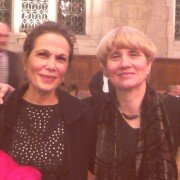Heidi and Julia – Part I
Heidi Jacob,
conductor and composer
Several years ago, my colleague Heidi Jacob took a sabbatical from conducting and teaching at Haverford College in order to study for her Ph.D. in composition. I was impressed; having earned two terminal degrees myself, I would not want to become a doctoral student again. Heidi was excited by the prospect, though; I could tell she couldn’t wait to plunge in.
She’s been back teaching for a couple of years, but I had yet to hear any of her compositions. So I was delighted to see a poster announcing that four of her songs based on poems of Julia Alvarez would be premiered on the Bryn Mawr College Creative Writing series, with Julia Alvarez herself in attendance.
“Tell me about this!” I said, when we saw each other in the hallway at the beginning of the semester.
With an enthusiasm she usually expresses for a particularly talented student we share, Heidi talked, eyes shining, not about herself, but about the great Dominican- American author’s work. “Gladys,” Heidi said. “Remember Gladys? The first song is about her.” We agreed we both loved How the Garcia Girls Got their Accents. And In the Time of the Butterflies. And Yo!
Accelerando to December 1, the evening of the premiere, which Bryn Mawr appropriately named “Words and Music.” When I arrived, a crowd had already gathered at Thomas Great Hall, on the majestically gothic Bryn Mawr campus.
Stepping into Thomas Hall is like stepping into a minor wing of the Houses of Parliament -– it is an enormous, rectangular space with a soaring ceiling, stone walls, and high mullioned windows. Acoustically it can be tricky, but the sound produced by L’Ensemble (the professional chamber group made up of Ida Faiella, soprano; Barry Finclair, violin, and Charles Abramovic, piano) was clear, focused, and full.
“Gladys sang as she worked
in her high, clear voice”
began Faiella, in her commanding, expressive soprano. Radiant, harplike colors produced by pianist Abramovic, and playful, sweet trills from violinist Finclair, gave Gladys Singing the compelling sound of tropical bird song.
However, nothing remains easy and amiable in this piece. At the end of Gladys Singing, the mother of the singer/narrator roars up the driveway in her powerful car, and in her high heels click-clacks up to the front door to enter the suddenly silent house. The birds stop singing, the music becomes static as a “tomb,” and the listener understands why Gladys, warm-hearted Gladys of the author’s childhood, became a muse and a symbol of life to her.
In the next song, Folding My Clothes, Heidi Jacob has changed the structure of Alvarez’s poem so that the bitter-sounding phrase composed to the final words
“until I put them on, breathing life back
into those abstract shapes of who I was
which she found so much easier to love”
is redeemed, musically, by the re-appearance of the rounded, berceuse-like first line, “Tenderly she would take them down and fold the arms in and fold again…”
“Are we all ill with acute loneliness” is the shortest song, yet terrifying in its bleak and deliberate use of pizzicato descending minor seconds (doubled by the piano) and the use of Sprechstimme to harshly speak the question, “and we are all well?”
The most dramatic song in the cycle is the final one, Beginning Again. In this complex piece, the listener is brought face-to-face with the immigrant girl’s sense of anxiety and loss, depicted by restless shifting meter and spiky dissonance. Gradually, the listener travels with the immigrant singer/narrator through reconciliation and hope, depicted by the use of an open-sounding descending modulation by thirds, an oasis of A major, a celestial-sounding B-flat major texture, and at the end, a sprightly and regular rhythmic pattern which brings us –- and are we not all immigrants, in our own way? — to the acceptance, and anticipation, of home.
With this last statement, Heidi Jacob achieves a satisfying symmetry for the cycle: the first and last songs are the longest, and, as the mood of the first song begins with comfort and ends with a sense of desolation, here, in the last song, the composer begins with unease and ends with hope.
Julia Alvarez address the audience in her musical voice
There was a pause following the enthusiastic applause as Julia Alvarez mounted the stage and took the microphone. With her high cheekbones and petite frame, she bears a resemblance to Bryn Mawr’s most famous alumna, Katherine Hepburn, though the glamour this night was endearingly softened by a green pencil stuck into her upswept bun. Clearly touched by the musical tribute, she looked straight into the audience and said, “Who needs a funeral?”
She then began to read her poems with the poise, timing, and phrasing of a fine musician.
It was ear-opening to hear the author read the same poem that Heidi had set to music with such different results, most notably in Folding my Clothes. The inflections were in different places, the cadence hypnotic. Occasionally I have found myself at poetry readings, brain straining, wishing I were at a concert instead, but not in this case. The pure words, as read in Alvarez’s musical voice, held the audience captive with phrasing as seductively compelling as a Chopin melody.
Her introductions to the poems she read and the pearls of wisdom she bestowed on young writers will be discussed in my next post.
After the reading, I asked Julia Alvarez what it was like to hear her words re-interpreted through music.
“Like I said, who needs a funeral?” she said, glowing. “Heidi was able to bring out the emotion inside the lines.”
I thought about that. Emotion is outlined, heightened and dramatized by music in a way that enhances the words. Music makes us listen in a different way, forces us to experience the words with greater intensity –- that is, when the words are good, and the music’s good. They certainly were that night.
Julia and Heidi,
words and music




